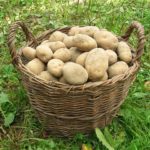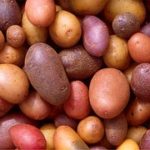 Hooray! A whole month to celebrate the potato! I really don’t need a reason. Potatoes are my comfort food. I’ve been known to stop on my way home from work just to get some hot mashed potatoes or to heat up some leftover potatoes from the previous night’s dinner.
Hooray! A whole month to celebrate the potato! I really don’t need a reason. Potatoes are my comfort food. I’ve been known to stop on my way home from work just to get some hot mashed potatoes or to heat up some leftover potatoes from the previous night’s dinner.
Potatoes sometimes get blamed for being a “bad” food. People remove it from their diets because they want fewer carbohydrates. Actually, the potato is very nutritious! A medium potato (with skin) contributes to the daily recommended value of Vitamin C (45%), potassium (18%), and fiber (3 grams) to the diet. It has no fat, cholesterol, or sodium. A medium potato has about 110 calories. Carbs provide energy and we should not totally remove them from our diet.
A potato serving is considered a 1 /2 cup. A baked potato serving is about the size of a computer mouse. Have you seen the size of some “baking potatoes” lately? They can be two, three or more times what the normal serving should be! Be aware that once some “additions” are added to top a baked potato, it may lose its healthy status. Some people will add melted cheese, bacon bits, butter, sour cream, chili, and other choices that can add fat and calories. It’s what we top it with or mix it up with that can make it become less than a healthy choice. Add broccoli, shredded carrots, or other shredded vegetables, and fat free sour cream or yogurt to top the potato.
Diabetics are usually taught to stay clear of starchy vegetables such as the potato. However, it can fit into your total daily food plan and carbohydrate count. A plain potato has about 26 grams of carbs. Watch the serving size and occasionally add it to a meal. Choose other vegetables and foods for the day’s meals that have no or few carbs to balance your total carbohydrate intake for the day.
There are many types of potatoes – russet, Yukon gold, red “new” potatoes, fingerlings. Potatoes can vary not only in color and size, but also in texture, flavor, and use. Have you ever had a purple potato? Yes, they are purple inside and not much  different than most potatoes– except for their color. Before preparing potatoes, or any vegetable, use a vegetable brush and scrub it under cool, running water to get the dirt off.
different than most potatoes– except for their color. Before preparing potatoes, or any vegetable, use a vegetable brush and scrub it under cool, running water to get the dirt off.
When buying potatoes look for clean potatoes that are smooth and do not have cuts, bruises, a green tint or “eyes.” Potatoes can be purchased in pre-weighed bags or by the pound. Check out the unit prices on the potato signs to determine which is a more economical purchase. But also keep in mind how quickly you will use the potatoes: a 10 pound bag may cost less per pound, but if you can’t eat them all before they go bad, it isn’t saving you money! For storage, keep your potatoes cool and in a well ventilated place out of light.
Enjoy the potato as part of a healthy diet. Just be smart about how you prepare it and how much you consume.

